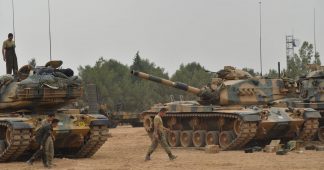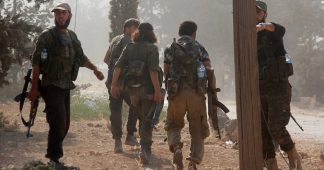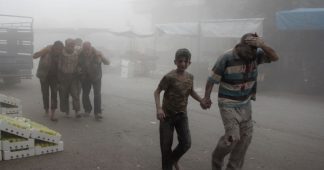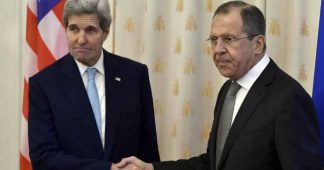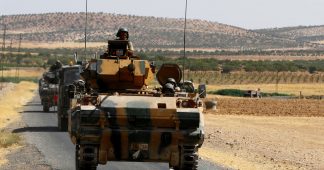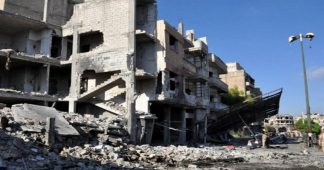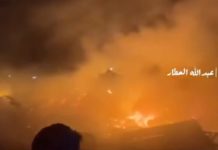US pushes for “no fly” zone as Syrian conflict escalates
By Bill Van Auken
Speaking before a United Nations Security Council meeting on Syria Wednesday, US Secretary of State John Kerry demagogically blamed Russia and the government of President Bashar al-Assad for the escalating violence that has left a ceasefire reached earlier this month in tatters.
Kerry also demanded the imposition of a de facto “no fly” zone over areas controlled by US-backed Islamist “rebels,” including those affiliated with Al Qaeda, under the pretext of assuring delivery of humanitarian aid and reviving the ceasefire.
“I believe that to restore credibility to the process, we must move forward to try to immediately ground all aircraft flying in those key areas in order to deescalate the situation and give a chance for humanitarian assistance to flow unimpeded,” Kerry told the Security Council meeting.
The Syrian government declared the ceasefire ended on Monday after reporting 300 violations by the Western-backed Islamist “rebels” and in the wake of the US bombing of a Syrian army outpost near the Deir al-Zor airport in eastern Syria on Saturday that killed as many as 90 soldiers and wounded another 100.
US officials have claimed that the attack was a mistake, while Damascus has pointed out that it was immediately followed by an assault on the position by fighters of the Islamic State (also known as ISIS), charging that the air and ground actions were coordinated. Deir al-Zor occupies a strategic position on the highway leading from Syria to Iraq and onto Iran.
The US airstrike was followed on Monday by an attack on a UN aid convoy in the town of Urum al-Kubra in northern Aleppo that left 20 people dead and 18 trucks bearing relief supplies destroyed. Washington immediately charged, without presenting any evidence, that either Russia or the Syrian government was responsible. Kerry and other US officials are now invoking the attack as a means of vilifying Moscow and pressing for new concessions.
Blaming Russia and the Assad government for Monday’s attack, Kerry claimed that it “raises a profound doubt about whether Russia and the Assad regime can or will live up to the obligations that they agreed to in Geneva.”
Speaking earlier, Russian Foreign Minister Sergei Lavrov described the attack on the aid convoy as “an unacceptable provocation,” and called for a “thorough and impartial” investigation to determine who was responsible. He repeated previous statements by Russian military officials that no Russian warplanes had been in the vicinity of the attack, adding that the Syrian air force was not capable of carrying out such an airstrike at night. He pointed out that the attack on the convoy coincided with a “rebel” offensive in the same area.
Russian military officials, meanwhile, reported Wednesday that a US Predator drone, capable of firing multiple air-to-surface missiles, was seen flying over the aid convoy at the time of the attack. Earlier, the Russian Defense Ministry released an aerial video showing that the aid convoy had been accompanied by a “rebel” truck towing a large-caliber mortar launcher, which subsequently disappeared from view.
In his statement to the Security Council, Lavrov also insisted that there could be no more “unilateral” cessations of hostilities in Syria. Russia has charged that the US-backed Islamists never accepted the ceasefire and continued to carry out attacks on government positions after it went into effect on September 12.
Speaking before the same Security Council meeting, Syria’s ambassador to the UN Bashar al-Jaafari vowed that his country “will not become another Libya or Iraq,” and stated that his government was prepared “to reach a political solution that is decided by the Syrians”
While Kerry claimed that his proposed “no-fly” zone is meant to prevent the Syrian government from attacking “civilian targets with the excuse that it is just going after Nusra,” from the standpoint of Washington’s aims, the exact opposite is the case.
As with its support for the ceasefire itself, Washington is invoking humanitarian concerns for civilians trapped in areas controlled by the Al Nusra Front and similar Al Qaeda-linked militias in order to bring a halt to Syrian military operations against these forces and thereby allow them to rearm, regroup and resume an offensive against the Assad government.
The Syrian ceasefire has been the subject of bitter divisions within the Obama administration, with the Pentagon and top uniformed commanders in the Middle East calling into question whether the military would even obey orders to implement the deal.
Those most heavily involved in the US-orchestrated war for regime change in Syria, particularly elements within the CIA, have opposed the agreement because it calls upon Washington to oversee the separation of the so-called “moderate opposition” that it has paid and armed from Al Qaeda-linked forces like the Al Nusra front that are formally designated as “terrorists.” In the week following the ceasefire’s initiation, there was no sign of these “moderates” distancing themselves from the Al Qaeda elements. Such a separation is opposed by Washington’s “rebels” because Nusra represents the most significant armed group fighting the Syrian government.
Even more importantly for the Pentagon, the ceasefire’s call for the establishment of a joint operations center with Russia to share intelligence and targeting information would cut across the US military’s escalating preparations for war with Russia itself. The bombing of the Syrian army position on Saturday, followed by the attack on the aid convoy on Monday, served to squelch this proposal.
Amid the diplomatic sparring between the US and Russia at the United Nations, there were multiple signs that the conflict in Syria is on the brink of a dangerous escalation, carrying with it the threat of a wider and even world war.
The US is considering a plan to begin directly arming the Syrian Kurdish fighters of the YPG (People’s Protection Units), according to unnamed officials quoted in a report published Wednesday in the New York Times. US special forces units have already been deployed alongside the Kurdish fighters and Washington has been at least indirectly arming them by feeding weapons to a smaller Syrian Arab militia force that fights alongside the YPG.
Nonetheless, the plan, which is reportedly under discussion in the US National Security Council, would represent an escalation of the US utilization of the Kurdish militia as a proxy force in its campaign against ISIS. It would also deepen tensions between Washington and the Turkish government of President Recep Tayyip Erdogan, which launched its own military incursion into Syria last month.
Operation Euphrates Shield, as the Turkish invasion of Syria has been dubbed, now also counts with a US special operations “advise and assist” mission. As the primary strategic goal of Ankara’s intervention is to prevent Kurdish forces from consolidating an autonomous entity on Turkey’s border, US special forces could end up facing each other on opposite sides of the battlefield.
Before leaving for the UN General Assembly meeting in New York City, Erdogan told reporters that the Turkish intervention had “cleared” an area of 900 square kilometers (about 350 square miles) of “terrorists,” by which he meant both ISIS and the Kurdish YPG. He added, “We may extend this area to 5,000 square kilometers as part of a safe zone.” Such an intervention would require the deployment inside Syria of thousands of Turkish troops.
Meanwhile, the Russian Defense Ministry announced Wednesday that the Russian navy’s flagship aircraft carrier, the Admiral Kuznetsov, is being deployed to the eastern Mediterranean to participate in military operations in Syria.
